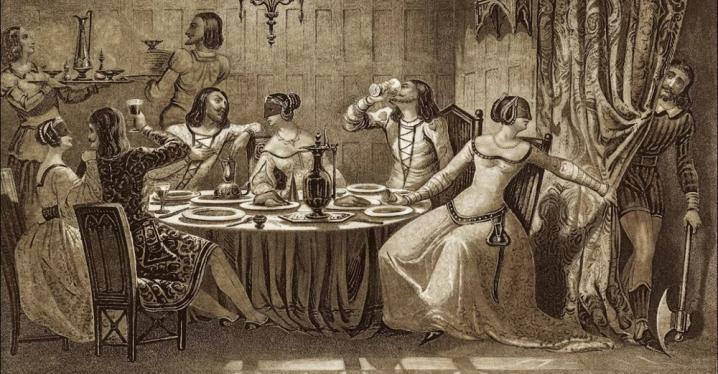The alleged affair that started a century-long war

“Heavy is the head that wears the crown,” wrote William Shakespeare. For three young women in the early 1300s, being the daughters-in-law of a king could be just as burdensome, especially when the sovereign was the ruthless Philip IV of France.
Like many kings before him, Philip IV was focused on the question of his succession. His dynasty, the Capets, had ruled France since the 900s, and to ensure its survival, Philip made strategic marriages for his children to secure alliances and heirs.
His three sons married French noblewomen, and his daughter, Isabella, wed King Edward II of England. But all his plans would come undone in 1314, when his children and their spouses were engulfed by the Nesle Tower affair. The scandal not only led to torture, imprisonment, and the possible murder of one of the princesses; it also led to a succession crisis in France that sparked the ruinous Hundred Years’ War.
(How Joan of Arc turned the tide in the Hundred Years’ War.)
Illicit affairs
The wives of all three of King Philip’s adult sons hailed from the neighboring region of Burgundy. Louis (the future Louis X) married Margaret, daughter of the Duke of Burgundy. Philip (the future Philip V) married Joan, daughter of the Count of Burgundy. Finally, Charles, (the future Charles IV) married Joan’s sister, Blanche of Burgundy.
Philip IV stands in the center of a group of men in a detail from a 14th-century miniature
Anxious to secure the Capetian dynasty, Philip IV (at center in a 14th-century miniature) married his sons to Burgundian noblewomen.
Only one of these marriages is recorded as being happy. Even by the standards of dynastic marriage, Margaret’s union with Louis was cold. Charles was overbearing with Blanche. Only Joan appeared to have been happily married to Philip, a bond that would later spare her from the miserable fates of her sisters-in-law.
The scandal began in 1313 when Isabella, King Philip’s daughter, visited Paris with her infant son, the future Edward III of England. Several chronicles describe a puppet show at which Isabella gave embroidered silk purses to her three sisters-in-law, Margaret, Blanche, and Joan.
On a later visit home, Isabella noticed that two knights accompanying her sisters-in-law—brothers Philippe and Gautier d’Aunay—were wearing those gifted purses on their belts. It is said Isabella saw these purses as a sign of an illicit liaison between the knights and her sisters-in-law, and she alerted her father in 1314.
On their own, the purses were unlikely to have been enough proof of adultery. Although during the Middle Ages, when women gave such presents to knights as favors, it was a practice often seen as a display of affection. But the king would need stronger evidence than that.
Philip IV ordered men to spy on his daughters-in-law and the two knights. Soon enough, he had reports that the three women were meeting with the two men at the Tour de Nesle, a guard tower on the Seine River in central Paris. All three princesses were seen coming and going at the tower, but only two of them—Margaret and Blanche—were having affairs with the knights.
An aerial view of the Château Gaillard fortress with a river in the background
Château Gaillard in Normandy, France, is the fortress in which Margaret and Blanche of Burgundy were incarcerated, and where Margaret died in 1315, perhaps as a result of murder.
Bruno The two d’Aunay brothers were arrested and imprisoned. Under torture, they confessed to the affair on April 19, 1314. Margaret and Blanche were imprisoned in the Château Gaillard fortress in Normandy. Although Joan was not involved sexually with the knights, she was accused of being an accomplice and incarcerated at Dourdan, near Paris. Nevertheless, she retained the support of her husband, who never disowned her.
(Inside the decadent love affair of Cleopatra and Mark Antony.)
Weighing the facts
Most historians believe that the affairs did happen, yet there is disagreement among scholars. Numerous primary sources documented the Nesle Tower affair. Among them are the Chronicles of the Count of Flanders; the Chronicle of the Kings of France by Guillaume de Nangis, a monk near Paris; and the Scalacronica, written by an English knight. These contradict each other in terms of chronology, so it is difficult to be sure of what events happened when. Cross-referencing these chronicles with royal household accounts, however, presents a rough time line.
One sticking point for numerous historians is that the d’Aunays’ resistance to torture lasted for days, leading some to think they were falsely accused and were trying to maintain their innocence. The Chronicles of the Count of Flanders put forward an interesting conspiracy theory: The princesses and the knights were innocent and framed by Philip IV’s principal minister, Enguerrand de Marigny. He was later accused of sorcery to harm the king and hung. Most historians, however, accept that Margaret and Blanche had committed adultery.
(Scandal and feuds are why you’ve never heard of these 7 geniuses.)
Taking liberties
A portrait of an actress portraying Margaret of Burgendy sitting in a chair
Margaret was portrayed by Gilda Darthy in a 1903 production.
Album
From the 1400s, fictional versions of the Nesle scandal recast Margaret of Burgundy as a femme fatale who delights in debauchery and murders her lovers. Alexandre Dumas developed this storyline in his 1832 play, The Tower of Nesle. A 1955 film, Tower of Lust, brought the story to the big screen.
Princesses and queens
After being condemned by the king in a secret trial, the knights were executed. Accounts vary on the exact details of their deaths, but all are very gruesome. Some say they were skinned alive and that their “manly parts” were cut off. They were decapitated and their remains were publicly displayed.





